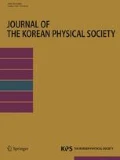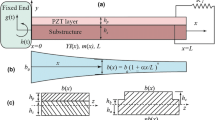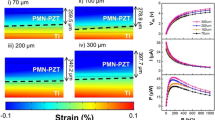Abstract
In the field of piezoelectric energy harvesting, a cantilever is widely used in a piezoelectric energy harvester (PEH) because it easily deforms under various forces and, generally, the output of the cantilever increases proportionally with the deformation. Naturally, many previous studies focused on how to obtain a higher PEH output. However, the power of the input source is limited, so the efficiency of the PEH must be maximized. In this study, based on the amount of input energy, the existence of an optimal efficiency of energy conversion in the PEH was researched. A plate-type PEH was first installed as the cantilever, and various masses were suspended from the free end of the PEH by using a thread. Next, the thread was cut while the PEH was in a bending state. Immediately, the PEH began vibrating with the input energy being the potential energy of the bent PEH, and the output was obtained. A maximum efficiency of 15.58% was determined in three ways: via the output electrical energy (0.46 mJ), the input potential energy (2.94 mJ), and the deflection value (at a free end position of 3.75 mm). Finally, the existence of the optimal efficiency based on the amount of input energy was found in this PEH.
Similar content being viewed by others
References
H. B. Fang et al., Microelectron. J. 37, 1280 (2006).
W. J. Choi et al., J. Electroceramics 17, 543 (2006).
S. Kim, W. W. Clarkand Q. M. Wang, J. Intell. Mater. Syst. Struct. 16, 847 (2005).
L. Mateu and F. Moll, J. Intell. Mater. Syst. Struct. 16, 835 (2005).
C. J. Rupp, A. Evgrafov, K. Mauteand M. L. Dunn, J. Intell. Mater. Syst. Struct. 20, 1923 (2009).
Y. K. Ramadass and A. P. Chandrakasan, IEEE J. Solid-State Circuits 45, 189 (2010).
G. K. Ottman, H. F. Hofmann, A. C. Bhattand G. A. Lesieutre, IEEE Trans. Power Electron. 17, 669 (2002).
X. Gao, W. H. Shihand W. Y. Shih, IEEE Trans. Ind. Electron. 60, 1116 (2013).
D. Guyomar, A. Badel, E. Lefeuvreand C. Richard, IEEE Trans. Ultrason. Ferroelectr. Freq. Control 52, 584 (2005).
M. Ferrari, V. Ferrari, D. Marioliand A. Taroni, IEEE Trans. Instrum. Meas. 55, 2096 (2006).
E. Lefeuvre, D. Audigier, C. Richardand D. Guyomar, IEEE Trans. Power Electron. 22, 2018 (2007).
A. Erturk and D. J. Inman, Smart Mater. Struct. 18, 025009 (2009).
J. H. Ahn et al., Sens. Actuators A 277, 124 (2018).
I. Izadgoshasb et al., Energy Convers. Manag. 161, 66 (2018).
W. Wang, J. Cao, C. R. Bowenand J. Lin, Energy 118, 221 (2017).
B. Bao, W. Chenand Q. Wang, Energy 116261 (2019).
J. H. Hyun, in Proceedings of IECON2018, 44th Annual Conference of the IEEE Industrial Electronics Society (Washington, USA, October 21–23, 2018), p. 4219.
J. Y. Cho et al., Appl. Energy 254, 113710 (2019).
J. Y. Cho et al., Sens. Actuators A 280, 340 (2018).
C. I. Kim et al., Appl. Phys. Express 5, 037101 (2012).
D. Kim et al., RSC Adv. 3, 3194 (2013).
H. Kim, S. Priya, H. Stephanouand K. Uchino, IEEE Trans. Ultrason. Ferroelectr. Freq. Control 54, 1851 (2007).
J. B. Penella and M. P. Vidal, J. Intell. Mater. Syst. Struct. 20, 597 (2009).
N. Kong, D. S. Ha, A. Erturkand D. J. Inman, J. Intell. Mater. Syst. Struct. 21, 1293 (2010).
G. A. Lesieutre, G. K. Ottmanand H. F. Hofmann, J. Sound Vib. 269, 991 (2004).
Z. Xie et al., Smart Mater. Struct. 28, 085027 (2019).
H. J. Jung, S. Lee, S. W. Jeongand H. H. Yoo, Smart Mater. Struct. 27, 114006 (2018).
Y. Liao and J. Liang, Smart Mater. Struct. 27, 075053 (2018).
M. Umeda, K. Nakamuraand S. Ueha, Jpn. J. Appl. Phys. 35, 3267 (1996).
M. Garcia-Rodriguez et al., Phys. Procedia 3, 1025 (2010).
Y. C. Shu and I. C. Lien, J. Micromech. Microeng. 16, 2429 (2006).
L. Gu, Microelectron. J. 42, 277 (2011).
Acknowledgments
This research was supported by the program for fostering next-generation researchers in engineering of the National Research Foundation of Korea (NRF) funded by the Ministry of Science & ICT (No. 2017H1D8A2032495).
Author information
Authors and Affiliations
Corresponding author
Rights and permissions
About this article
Cite this article
Ryu, C.H., Hwang, W., Cho, J.Y. et al. Optimization of the Energy Conversion Efficiency by Bending Deflection Piezoelectric Cantilever Beams. J. Korean Phys. Soc. 76, 948–953 (2020). https://doi.org/10.3938/jkps.76.948
Received:
Revised:
Accepted:
Published:
Issue Date:
DOI: https://doi.org/10.3938/jkps.76.948




